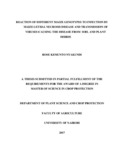| dc.description.abstract | Maize (Zea mays) is a key cereal crop in sub-Saharan Africa (SSA). It is the staple food for more than 1.2 billion people in the developing countries. Maize production faces many pests and disease challenges. In 2011, there was an outbreak of a disease in Kenya, Maize lethal necrosis (MLN), caused by a synergistic interaction of two viruses, the Maize chlorotic mottle virus (MCMV) and the Sugarcane mosaic virus (SCMV). The disease causes up to 100% crop loss and has threatened food security in Kenya. This study aimed at determining how commonly grown genotypes react to infection by the viruses causing the disease and to determine the role of soil and crop debris in disease epidemiology.
Five maize genotypes H614, H513, Duma 43, Kikamba and Kinyanya were used. The genotypes were selected based on the Agro Ecological Zones (AEZ) they are grown and whether it is a hybrid or a landrace genotype. The genotypes were planted in a screenhouse at the University of Nairobi, Upper Kabete campus Field Station and inoculated with MCMV, SCMV, the combination of the two (MCMV+SCMV) and with inoculum from plants with combined viruses (MLN). The plants were assessed for disease incidence and severity and data analysis done using Genstat package version 12. The area under disease progress curve (AUDPC) was used to compare the severity of the different treatments. Serological analysis on the collected samples was done using double antibody sandwich enzyme linked immuno-sorbent assay (DAS-ELISA). On completion of the experiment, the plant debris were cut into small pieces and mixed with the soil. Half of the bags were left without the debris to assess if there was any significant difference if infested soil alone or with debris enhanced the acquisition of the viruses from the soil. The same soil was used again for a third planting to check if the viruses could still be viable to cause infection.
All the genotypes evaluated developed disease symptoms after viral inoculations, although the landraces developed symptoms earlier than the hybrids. The landraces also had higher disease incidences in earlier weeks and showed more severity. All genotypes had >90% disease incidence with the combination of the two viruses (MCMV+SCMV) recording the highest disease severity of 4.94 on the landrace Kinyanya. Significant differences in both incidence and severity were noted in MCMV+SCMV treatment while the other treatments had no significant differences. The combination also recorded the largest area under disease, with the Elisa results indicating the doubling of the MCMV virus titer in the presence of SCMV while it remained unaffected in single infections.
There was no significant difference when soil had infected debris or only infested soil in the efficiency of transmiting the virus to the the newly planted maize. However, the landraces showed symptoms of the acquired viruses immediately on emergence. Higher disease incidence was reported on the landraces than on hybrids with severity being high also on the landraces. However, no significant difference was noted among the tested maize genotypes. In the third planting to check if any plants acquire the viruses; disease incidence was low with the highest being 36.1% for SCMV on Kikamba and lowest at 0% for Duma 43 in MLN treatment. All the genotypes tested were infected by MLN disease and its causal viruses with the landraces being the worst affected. The genotypes also acquired the viruses from the soil with the landraces showing symptoms immediately on emergence. From the above findings, use of certified seeds, crop rotation, and field hygiene including removal and burning of infected plant should be practiced to avoid repeated infections of maize plants and buildup of viral inoculum. | en_US |



